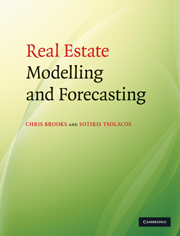Book contents
- Frontmatter
- Contents
- List of figures
- List of tables
- List of boxes
- Preface
- Acknowledgements
- 1 Introduction
- 2 Mathematical building blocks for real estate analysis
- 3 Statistical tools for real estate analysis
- 4 An overview of regression analysis
- 5 Further issues in regression analysis
- 6 Diagnostic testing
- 7 Applications of regression analysis
- 8 Time series models
- 9 Forecast evaluation
- 10 Multi-equation structural models
- 11 Vector autoregressive models
- 12 Cointegration in real estate markets
- 13 Real estate forecasting in practice
- 14 The way forward for real estate modelling and forecasting
- References
- Index
13 - Real estate forecasting in practice
Published online by Cambridge University Press: 05 June 2012
- Frontmatter
- Contents
- List of figures
- List of tables
- List of boxes
- Preface
- Acknowledgements
- 1 Introduction
- 2 Mathematical building blocks for real estate analysis
- 3 Statistical tools for real estate analysis
- 4 An overview of regression analysis
- 5 Further issues in regression analysis
- 6 Diagnostic testing
- 7 Applications of regression analysis
- 8 Time series models
- 9 Forecast evaluation
- 10 Multi-equation structural models
- 11 Vector autoregressive models
- 12 Cointegration in real estate markets
- 13 Real estate forecasting in practice
- 14 The way forward for real estate modelling and forecasting
- References
- Index
Summary
Learning outcomes
In this chapter, you will learn how to
establish the need to modify model-based forecasts;
mediate to adjust model-based forecasts;
assess the contributions and pitfalls of intervention;
increase the acceptability of judgemental intervention;
integrate econometric and judgemental forecasts;
conduct ‘house view’ forecasting meetings; and
make the forecast process more effective.
Having reviewed econometric techniques for real estate modelling and forecasting, it is interesting to consider how these methodologies are applied in reality. Accordingly, this chapter focuses on how forecasting is actually conducted in the real estate field. We address key aspects of real estate forecasting in practice and provide useful context both for the preparer and the consumer of the forecasts, aiming to make the forecast process more effective.
There are certainly firms or teams within firms that overlook the contributions of econometric analysis and form expectations solely on the basis of judgement and market experience. In most parts of the industry, however, econometric analysis does play a part in forecasting market trends. Of course, the question that someone will ask is: ‘Does the real estate industry adopt model-based forecasts at face value or does some degree of mediation take place?’ The short answer to this question is that, independent of the level of complexity of the econometric or time series model, it is the convention to adjust model-based forecasts to incorporate judgement and expert opinion.
Information
- Type
- Chapter
- Information
- Real Estate Modelling and Forecasting , pp. 414 - 433Publisher: Cambridge University PressPrint publication year: 2010
